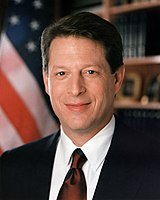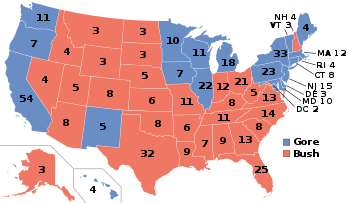2000 Presidential Election
|
|
|||||||||||||||||||||||||||||
|---|---|---|---|---|---|---|---|---|---|---|---|---|---|---|---|---|---|---|---|---|---|---|---|---|---|---|---|---|---|
|
|||||||||||||||||||||||||||||
|
All 538 electoral votes of the Electoral College 270 electoral votes needed to win |
|||||||||||||||||||||||||||||
| Turnout | 51.2% |
||||||||||||||||||||||||||||
|
|||||||||||||||||||||||||||||
|
Presidential election results map. Red denotes states won by Bush/Cheney, blue denotes those won by Gore/Lieberman. One of D.C.'s three electors abstained. Numbers indicate electoral votes allotted to the winner of each state.
|
|||||||||||||||||||||||||||||
|
|||||||||||||||||||||||||||||
The United States presidential election of 2000 was the 54th quadrennial presidential election. It was held on Tuesday, November 7, 2000. Republican candidate George W. Bush, then-incumbent governor of Texas and son of 41st President George H. W. Bush, narrowly defeated the Democratic nominee Al Gore, then-incumbent vice president and former Senator for Tennessee, as well as various third-party candidates including Ralph Nader.
Incumbent Democratic President Bill Clinton was ineligible to serve a third term due to term limitations in the 22nd Amendment of the Constitution, and Vice President Gore was able to secure the Democratic nomination with relative ease. Bush was seen as the early favorite for the Republican nomination and, despite a contentious primary battle with Senator John McCain and other candidates, secured the nomination by Super Tuesday. Bush chose former Secretary of Defense Dick Cheney as his running mate, while Gore chose Senator Joe Lieberman as his. Both major party candidates focused primarily on domestic issues, such as the budget, tax relief, and reforms for federal social insurance programs, although foreign policy was not ignored. Clinton and Gore often did not campaign together, a deliberate decision resulting from the Lewinsky sex scandal two years prior.
...
Wikipedia




